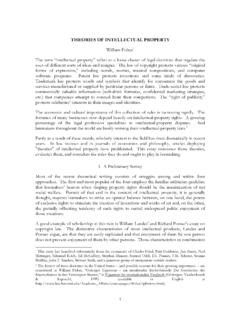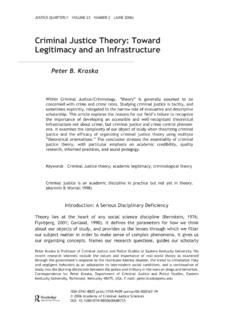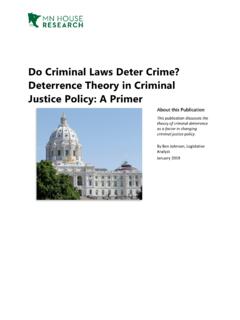Transcription of John Rawls' Theory of Justice as Fairness
1 ANDREAS FOLLESDAL 20121025 John Rawls' Theory of Justice as Fairness Approximately as appears in Guttorm Floistad, ed. Philosophy of Justice , Contemporary Philosophy, Springer 2014, 311-328 When do citizens have a moral duty to obey the government and support the institutions of society?1 This question is central to political philosophy. One of the 20 century's main response was John Rawls' Theory of Justice , " Justice as Fairness ", in the book A Theory of Justice , published 1971. The book Justice as Fairness was an improved and shorter presentation of Rawls' Theory , published 2001 with editorial support by Erin Kelly, one of his former students. When asked how rights, duties, benefits and burdens should be distributed, the ideals of freedom and equality often conflict with each other.
2 In domestic politics we often see such conflicts between calls for more individual freedoms and schemes for universal, egalitarian welfare arrangements. It is such conflict between liberty and equality that Rawls attempts to reconcile with his Theory of Justice . There are three main steps in Rawls' Theory of Justice . He assumes certain features characteristic of free societies, as well as some specific ideas about how society and people should be understood. Rawls believes that even people with different beliefs can agree with some principles to resolve basic conflicts over the distributional effects of social institutions. Secondly, he draws on the contract Theory tradition in political philosophy, arguing that consent in some sense is necessary for the legitimate exercise of state power.
3 Based on the requirement of consent, in a third step Rawls presents certain principles for a just society that citizens should be expected to support. The main idea of these principles is that political and civil rights must be protected, and that all individuals with the same abilities and efforts must be guaranteed equal opportunity to achieve different positions. Within this framework, those social groups who are most disadvantaged are given decisive weight in the distribution of economic benefits. Rawls' Theory is an alternative to utilitarianism, which had been dominant among philosophers and political thinkers since the mid-18th century. Notable politicians, economists and moral philosophers such as Adam Smith, Jeremy Bentham, John Stuart Mill and Henry Sidgwick had all advocated utilitarianism in one form or another.
4 This tradition asserts the principle of welfare maximization: One should act so as to achieve as large expected utility as possible, considering all stakeholders. Welfare, understood either as happiness or satisfaction of interests, is the only thing that matters to utilitarianism, and the distribution of welfare between the parties concerned have no essential meaning. Utilitarianism thus claims that it may be appropriate to let someone suffer if necessary to 1 An original version of this article appeared as an introduction to John Rawls: Rettferdighet som rimelighet , (Erin Kelly, ed. Justice as Fairness ) translated by Kai Swensen, Oslo: Pax 2003, 11-36. The present version was developed under the auspices of ERC Advanced Grant 269841 MultiRights on the Legitimacy of Multi-Level Human Rights Judiciary; and partly supported by the Research Council of Norway through its Centres of Excellence Funding Scheme, project number 223274 PluriCourts The Legitimacy of the International Judiciary.
5 - 2 - promote the overall welfare. Rawls denies this, claiming instead that each individual has certain rights that can not be sacrificed simply for others to obtain more benefits. A Theory of Justice is perhaps that contribution in political philosophy that has attracted most attention in the 20th century. The book revolutionized moral philosophy, and Rawls' critics declared quickly that political philosophers now must either work within his Theory or explain why they chose not to do so. Although the book is long and difficult to read, it has had a major influence far beyond the philosophers' series, in law, psychology, political science and economics. Yet A Theory of Justice was challenged on many issues, and Rawls continued responding to critics ever since the book appeared.
6 On some issues he adjusted his views in the light of objections and suggestions, he has often modified and explicated the Theory to get a better account than he originally presented. Sometimes he has refuted criticism. In the end, Rawls chose not to revise A Theory of Justice , but rather note changes in articles, as well as in the book Political Liberalism, where he developed his thoughts further. The book Justice as Fairness is a shorter and updated presentation to a large extent on Rawls' written lecture notes from the 1980s. This introduction of Rawls falls into eight parts. After a brief biographical introduction, Part 2 presents the allocation principles he advocated. Part 3 presents Rawls' conception of society and the individual, as an introduction to the rest of the argument presented in part 4 Section 5 takes up his Theory of justification, and part 6 points to three areas where the more recent book Justice as Fairness differs somewhat from A Theory of Justice .
7 Section 7 presents some of the criticisms that have been raised, and section 8 points to some lasting contributions of Rawls Theory . Social and Historical Context John Rawls was born in the state of Maryland in the United States in 1921. With the exception of three years of military service during the 2nd World War he devoted his working life to philosophy. He received his in philosophy at Princeton University in 1950 and taught briefly there and at Cornell University in 1962 before he was offered a professorship in philosophy at Harvard University. When A Theory of Justice was published, he had worked on the book for 20 years. A Theory of Justice is characterized by the analytical philosophy's emphasis on conceptual analysis and detailed argument.
8 Why, A Theory of Justice caused such attention? Political philosophy seeks to increase our understanding of how society is and how it should be. John Rawls emphasized that this understanding has an important practical goal, namely to help resolve deep conflicts between community members. Rawls, born and raised in the South of the US, felt strongly that American society suffered from the lack of a well thought out response to the question of how a just society should regulate the distribution of benefits and burdens of cooperation between members. This is the issue he devoted his life to answer. One of the reasons that A Theory of Justice has had such an impact is undoubtedly that Rawls took the views of others seriously, and sought to benefits from the insights of earlier thinkers.
9 Rawls often emphasized that if we are to learn from others, we must interpret them in the best light. It thus leads astray to believe that political philosophers throughout world history have given different answers to exactly the same questions. To the contrary, they often wrote with - 3 - current political conflicts in mind. Historical insight is therefore necessary to put the theories in a fair light and to harvest other's insights. When earlier thinkers sounds as naive, it is thus often because our interpretation of them is wrong. This attitude led Rawls to ask: What is the historical context for this author s writing, and what questions concern him or her? What options do they perceive as possible? Many of the critics of A Theory of Justice failed to aske such questions about Rawls' own contributions.
10 Though such background helps to understand why the book caused such a stir due to the political and philosophical conflicts of Rawls' time. In the middle of the 20th century the United States was marked by deep political conflicts. The Civil Rights Movement in the 1950s and 60s posed fundamental questions about social life and governance in the US. Their role in the Vietnam War further focussed public attention on governmental legitimacy: By what moral right may the political authorities require that community members must obey society's rules and regulations? Rawls argues that legitimacy is primarily a question of Fairness : how rights and benefits are distributed among people. In a democracy, the public legal and political order must ensure political equality.





